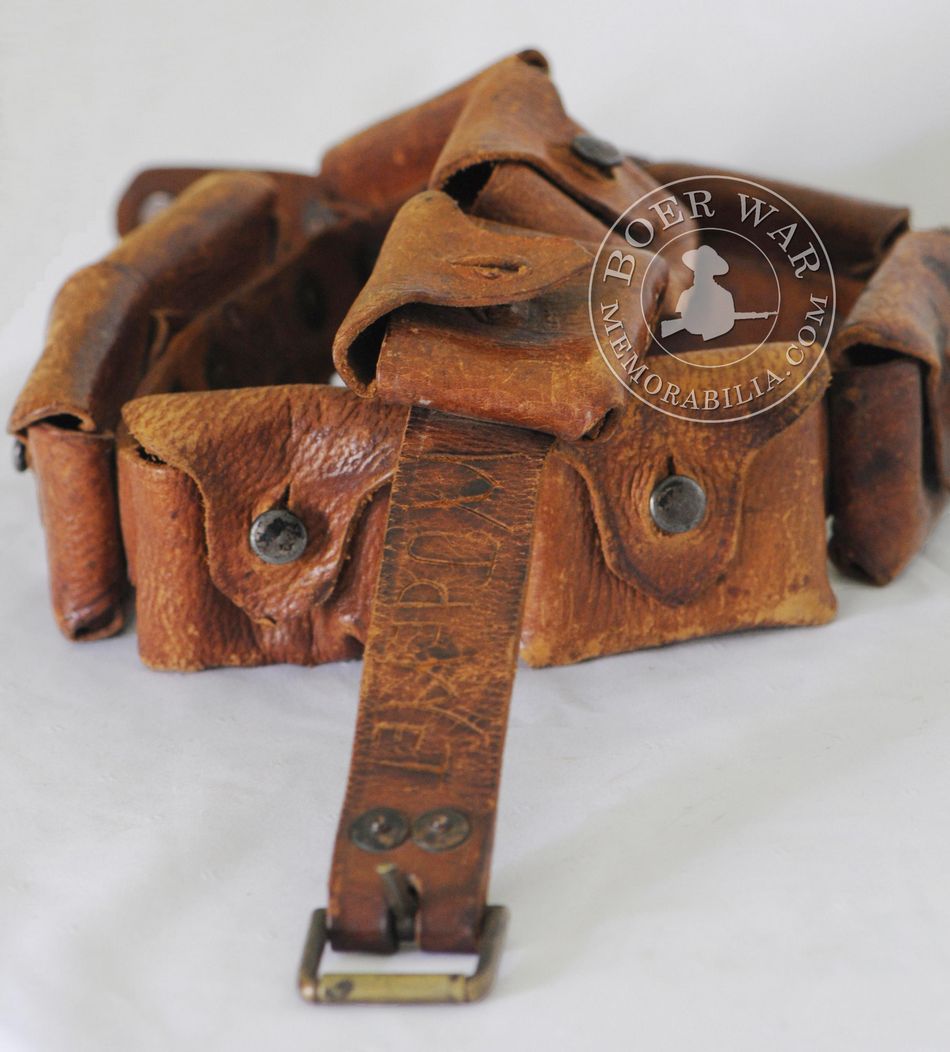|
View the embedded image gallery online at:
https://boerwarmemorabilia.com/index.php/memorabilia/military-insignia/item/98-bandolier-1-boer-forces#sigProId9a68f5e800 |
Item Ref# KS6121
Bandolier 1 - Boer Forces
Brief description: This is an original Boer’s leather bandolier – with the previous owners name - marked “de Wet”. It contains the typical 12 pouches, each holding a typical 5 round clip of Mauser ammunition. These bandoliers were found normally holding 12 or 6 pouches. Material: Leather Manufacturer: tbc Artist: N.A. Circa: 1885 Dimensions: tbc Weight: tbc Inscription: “de Wet” |

Boer Bandoleirs
At the outbreak of the Boer War almost every burgher carried a shoulder worn bandolier. The two Boer republics each had its own version of the Commando Law by which male citizens with voting rights and between the ages of 16 and 60 were eligible for commando service. By law the burghers were expected to supply themselves with a serviceable rifle, 30 rounds of ammunition, a horse and clothing as well as food and supplies for eight days. After eight days the government would provide in their needs. This system had worked well during earlier small wars against native tribes, but proved insufficient during the extended war against the British Empire.
By late 1899 most of the leather bandoliers in stock had been issued and worn items could not be replaced. This resulted in a large variety of locally made ersatz (replacement) leather and cloth bandoliers making their appearance. These were either made at home or by commandeered contractors and saddlers, possibly even well known Transvaal uniform and equipment supply companies like Beckett & Co. and Johnston & Co.
Single Tube Leather Bandoliers and Belts
One of the oldest and most basic shoulder or waist worn ammunition carriers was the single tube leather bandolier.
Most single loop bandoliers were sized for .450-inch rifle and carbine ammunition and were leftovers from earlier wars when the Martini-Henry (MH) was the preferred firearm of both Boer and Brit. By 1899 the MH had been superseded by smaller calibre magazine rifles and was therefore semi-obsolete. However, a number of individuals preferred the larger sized rounds and shortages during the war on both sides resulted in several older rifles and bandoliers of this design seeing service with Boers and Colonial reserve units like town guards. Several bandoliers of this design were also manufactured and used for smaller calibre ammunition during the war.
British MI Pattern 1889 Bandolier
This equipment was officially listed as “Bandolier, Leather (.303-inch), Ammunition. Mounted Infantry, 50 rounds, with steadying strap”.
On British side the Pattern 1889 was one of the most common ammunition bandoliers worn during the Boer War. On Boer side the Transvaal captured a number of bandoliers of this design from the British Jameson Raiders and the Johannesburg Reformers before the war. Boer War photos however show several Boers wearing this type of bandolier and therefore it is suspected that more examples were manufactured locally or purchased from Britain, Natal or the Cape Colony before the war.
Converted MI Bandoliers
Interestingly, a number of photos show burghers wearing Pattern 1889/1897 style bandoliers that were modified to take 7x57mm Mauser ammunition in their 5-round stripper clips. This was either done by removing some of the stitching between the individual tubes, or some examples were custom made to carry Mauser loading clip and were based on the MI bandolier family. Whichever the case, the construction of these bandoliers were similar to the normal British MI bandoliers with four long and two short flaps closed by means of tabs and brass studs.
ORANJE VRIJSTAAT ARTILLERIE CORPS/ Historical Study and Re-Enactment Group
| Scripture |
|
The LORD is my light and my salvation; whom shall I fear? The LORD is the strength of my life; of whom shall I be afraid?
Psalm 27:1 |

